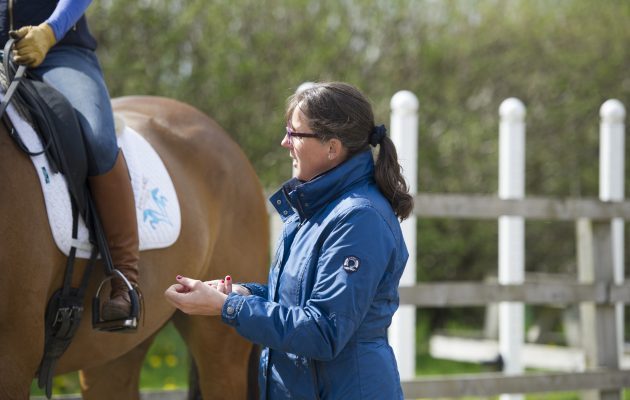If this is the year you’ve decided to allow your pony-mad child to get in the saddle for the first time, here is our expert guide to what clothes and kit they need to have. Going all out with a full wardrobe of children’s horse riding clothes can get expensive, so it’s best to start with the essentials and add extras over time.
The two essential bits of riding kit for children are a riding hat and correct footwear. Optional but advisable extras include a body protector, a pair of jodhpurs or riding tights, and riding-specific gloves. There is so much choice when it comes to riding wear for children, but it is really important that you choose products that fit well and comply with the current safety standards so they are safe and comfortable.
Children’s horse riding clothes: what beginners should wear
Riding hats
A helmet is the most important piece of kit and no child should be allowed to get on a horse without one. We also recommend that a helmet is worn whenever children are around or handling horses. Riding schools often have hats that you can borrow or rent for a one-off lesson before your child commits and needs their own.
When buying a hat, you should choose a hat that complies with a current standard, such as PAS 015 (1998 or 2011). Riding schools usually stipulate which they accept and whether they require a British Kitemark or other quality marks, as do Pony Club and other governing bodies, so it’s best to check this first. Understanding how riding hats are tested may also help you decide which hats might make your shortlist.
H&H recommends that all hats should be fitted by a BETA-trained retailer – find your nearest one here. Hats that have been professionally fitted can then be bought in store or ordered online, but you should never purchase second-hand as there is no way to tell if it has been dropped or the internal parts damaged. Any hat that has been dropped or had an impact in a fall needs to be replaced.
- Here is our guide to the best children’s riding hats. You can also check out our other guides to the best riding hats, best jockey skulls, best adjustable riding hats and riding hats under £100.
Footwear
Children’s riding boots need to be comfortable to wear in and out of the saddle with a suitably grippy sole, small heel and made of a hardwearing material. Real leather generally gives better breathability than synthetic options, but it requires more care and is often more expensive. Most junior riders find short (jodhpur) boots give them better control of their lower legs and a pair that has a zip front and/or elastic paneling will be easier to take on or off while still achieving a snug fit. Alternatively, long riding boots offer more protection to a child’s legs and may be preferred by some, or you can pair half chaps with jodhpur boots to reap some of the benefits of long boots without buying another pair.
- Here is our guide to the best children’s riding boots. You can also check out our guides to the best jodhpur boots, best long riding boots, best riding boots for wide calves and best riding boots on a budget.
Clothing
Jodhpurs are designed to keep your child comfortable and secure in the saddle – some even have grippy seats to prevent slipping. You can also opt for riding tights, which are designed more like leggings, are pull-on in style and also have the option of a grippy seat. Traditionally, competition jodhpurs should be white, cream or beige, but for everyday riding your son or daughter can choose whichever colour they prefer.
- Check out our guides to the best jodhpurs for children and best riding tights for children.
Gloves prevent friction burns and blisters from the reins and provides extra grip, while also keeping hands warm in the winter. The best gloves for horse riding have good grip on the palms but with minimal extra bulk so that your child can still feel the reins well. Normal winter gloves are not suitable for horse riding.
- Check out our guides to the best children’s riding gloves.
Body protector
A body protector is designed to absorb the impact from a fall or kick from a horse and can make an inexperienced young rider feel more confident. They are not essential for typical riding lessons, but many parents opt for their children to wear one.
Just like with hats, a body protector needs to be fitted by a BETA-trained retailer and should have a purple (2009) or blue (2018) BETA label, which shows it’s of the correct standard. The most comfortable body protectors are lightweight, well-ventilated and flexible so that the rider doesn’t feel hindered and is comfortable on and off the horse.
- Check out our guides to the best children’s body protectors for horse riding
You might also like:

10 riding hats that are perfect for children

Children’s riding boots for all ages, abilities and budgets

Looking for jodhpurs and breeches for girls and boys? Check these out…

Comfy and casual riding tights for young riders – ages 3-16

14 pairs of children’s riding gloves suitable for first timers and competitive riders

Subscribe to Horse & Hound magazine today – and enjoy unlimited website access all year round
Horse & Hound magazine, out every Thursday, is packed with all the latest news and reports, as well as interviews, specials, nostalgia, vet and training advice. Find how you can enjoy the magazine delivered to your door every week, plus options to upgrade your subscription to access our online service that brings you breaking news and reports as well as other benefits.









